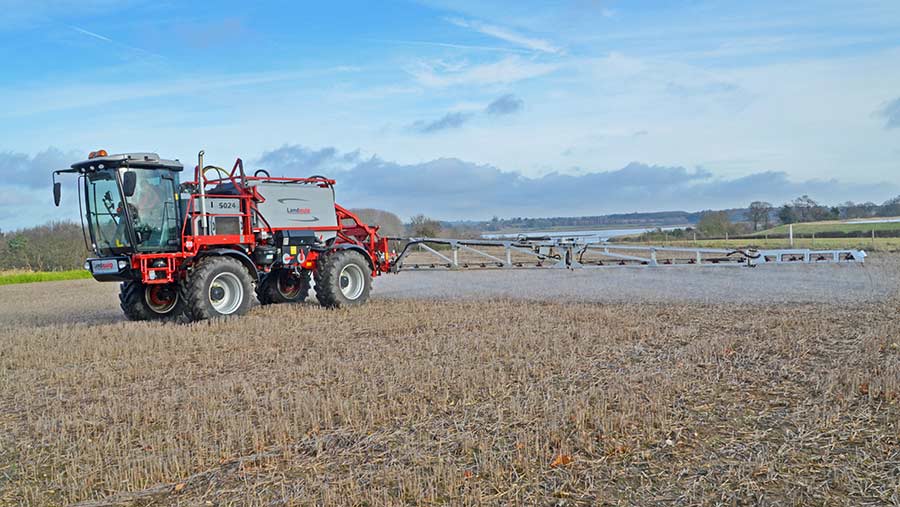Driver’s view: Suffolk farmer rates his 2018 Landquip CV228
 © Nick Fone
© Nick Fone We asked five operators to run through the good points and bad points of their self-propelled sprayers and explain why they picked them.
This time we’re focusing on British-built machines from Sands, Househam, Chafer, Landquip and Bateman, all with tank sizes of between 4,000 and 5,000 litres.
We start with Nick Blower and John Tooley talking about their 2018 Landquip CV228.
See also: Driver’s view: Beds farmer rates his trailed Horsch Leeb sprayer
Fact file: 2018 Landquip CV228
- Operators Nick Blower and John Tooley
- Company Kirton Farming, near Ipswich, Suffolk
- Farm size 850ha (750ha arable plus 100ha of land let for potatoes and onions)
- Soils Light sandy loams through to silty clays
- Crops grown Wheat, barley, beans and sugar beet

The Kirton team © Nick Fone
What sprayer are you using?
It’s a 5,000-litre Landquip CV228 fitted with 24m Pommier aluminium booms. It arrived last spring replacing an eight year old CV225 with a 3,500-litre tank.
Because we use liquid N fertiliser, the sprayer comes under a lot of pressure through the spring.
With increasingly tight weather windows through that period we needed more capacity to make sure we got round everything without compromising timeliness.
To further take the pressure off, we’ve also moved back to using 50% granular nitrogen, hence the decision to stick with 24m tramlines to guarantee accuracy from our Kuhn Axis spreader.
We had excellent service out of our old Landquip and the only issues we had were niggly things.
Being just 30 miles from their HQ, we get excellent back-up should anything go wrong and their staff know the machine backwards.
When we’re deep in that busy spring bottleneck spraying 14-18 hours a day, we can’t afford any downtime so having them on the doorstep is a godsend.
Like our old machine, the new sprayer uses a Househam skid-unit – chassis, engine, transmission and cab – with the Landquip spray-pack and Pommier booms.
It’s a combination that we’ve proven works really well for us so there was no need to move away from what we know.
Machine stats
- Price paid £200,000
- Year 2018
- Hours 297
- Engine Mercedes MTU four-cyl turbo
- Power 228hp
- Transmission Sauer-Danfoss
- Road speed 40kph
- Tank size 5,000 litres
- Pump 700 litres/min Hypro 9306 centrifugal
- Nozzles 3 x Lechler IDK twin fans plus 0.3 and 0.4 flat fans on 5-way rotary nozzle bodies
- Auto shut-off 12-section Pneumax
- Boom levelling Manual
- Guidance Househam TMC
- Boom width 24m aluminium Pommiers
- Wheel sizes Mitas 380/85 R 34 row crops / Michelin 600/60 R 30 floatations
- Average daily output 200-300ha/day
How has it performed?
Having over 40% more tank capacity has made a huge difference to our daily work rates simply by reducing our downtime running back to refill.
Where previously it would take five to six days to get round our entire acreage, we can now do it in three.
The other big factor is the new machine’s extra stability. Being about 0.4m longer, the heavy bits are centrally positioned between the axles so it’s well balanced whether full or empty.
On top of that, a move to a parallelogram linkage from a ladder-frame means boom movements are less erratic on undulating ground.
The Pommier corrosion-proof aluminium booms are lightweight, so they aren’t as prone to stress fractures when travelling at high speeds
We can now reliably travel at 15-18kph, which means that in a normal nine-hour day we can comfortably cover 200-250/ha.
If we really need to push it and weather conditions allow, we can do 350-400/ha by double-shifting the sprayer.
Likes
- Longer chassis better balanced whether fully loaded or empty
- Tier IV Merc engine noticeably quieter and more torquey for hill-climbing
- Reduced pipework means fewer places for residues to hang up, making washdowns faster
- Hydraulically adjustable wheel-track a luxury but great to have when switching from 72in to 80in centres
Gripes
- Cab lacks stowage for pens, paperwork, calculators and phones
- Poor visibility to tank level gauge when full
- Rear-view camera doesn’t show nozzles behind tank
- Early problems with hydraulic unions, cable routing and wiring connections on the tractor unit
How can it be improved?
We’ve struggled to come up with much as we genuinely feel that there aren’t many better sprayers on the market.
The cab lacks decent stowage for things like pens, calculators and paperwork and could really do with a phone holder, even if it was just a simple tray.
But you’re looked after on the catering front – there’s a proper fridge under the passenger seat and a drinks cooler in the roof.
Visibility is generally good, but the lower half of tank level gauge isn’t visible from the seat without leaning right across to see around the corner of the tank.
It’s not that much of a problem as the indicator rises towards the top as the tank empties.
The positioning of the rear-view camera could be improved to spot blocked nozzles behind the tank.

© Nick Fone
Any major breakdowns?
In a year there hasn’t been a single issue with the spray pack. However, there were some teething troubles with the skid-unit.
It was nothing major – just silly little things like leaking hydraulic unions, badly routed cables and poor wiring connections.
But it didn’t cause us any significant headaches. Househam was very quick to come out and resolve the issues, and we still had our old sprayer for us to fall back on.
We’ve also got Landquip’s Stack-and-Jack system for changing the wheels. It has a 15t bottle jack at the top and four interlocking steel sections to get it to the correct height without using wobbly piles of wooden blocks.

